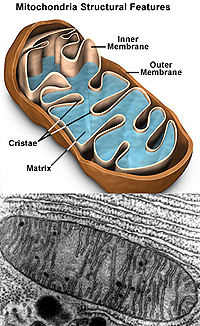|
 Mitochondria consist of an
outer membrane and a highly folded inner membrane (cristae) and are
generally tubular in shape.Their number, size, and shape relate to
the cell’s energy requirements. Mitochondria consist of an
outer membrane and a highly folded inner membrane (cristae) and are
generally tubular in shape.Their number, size, and shape relate to
the cell’s energy requirements.
- Mitochondria are unique
organelles because they contain their own genome and machinery
for protein production.
- The mitochondrial matrix contains
the enzymes for Beta-oxidation of fatty acids and citric acid cycle,
and the numerous cristae increase the surface area for ATP
synthesis.
- Although they are acidophilic,
mitochondria are usually not seen with the LM unless they are very
abundant or special stains or histochemical techniques are used.
- Histochemical staining uses specific
enzymes of the citric acid cycle, which are only found in
mitochondria. These staining techniques can be used clinically to
aid in the diagnosis of diseases associated with mitochondrial
dysfunction.
Now for
cytoplasmic inclusions. |